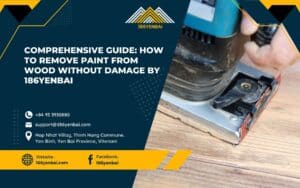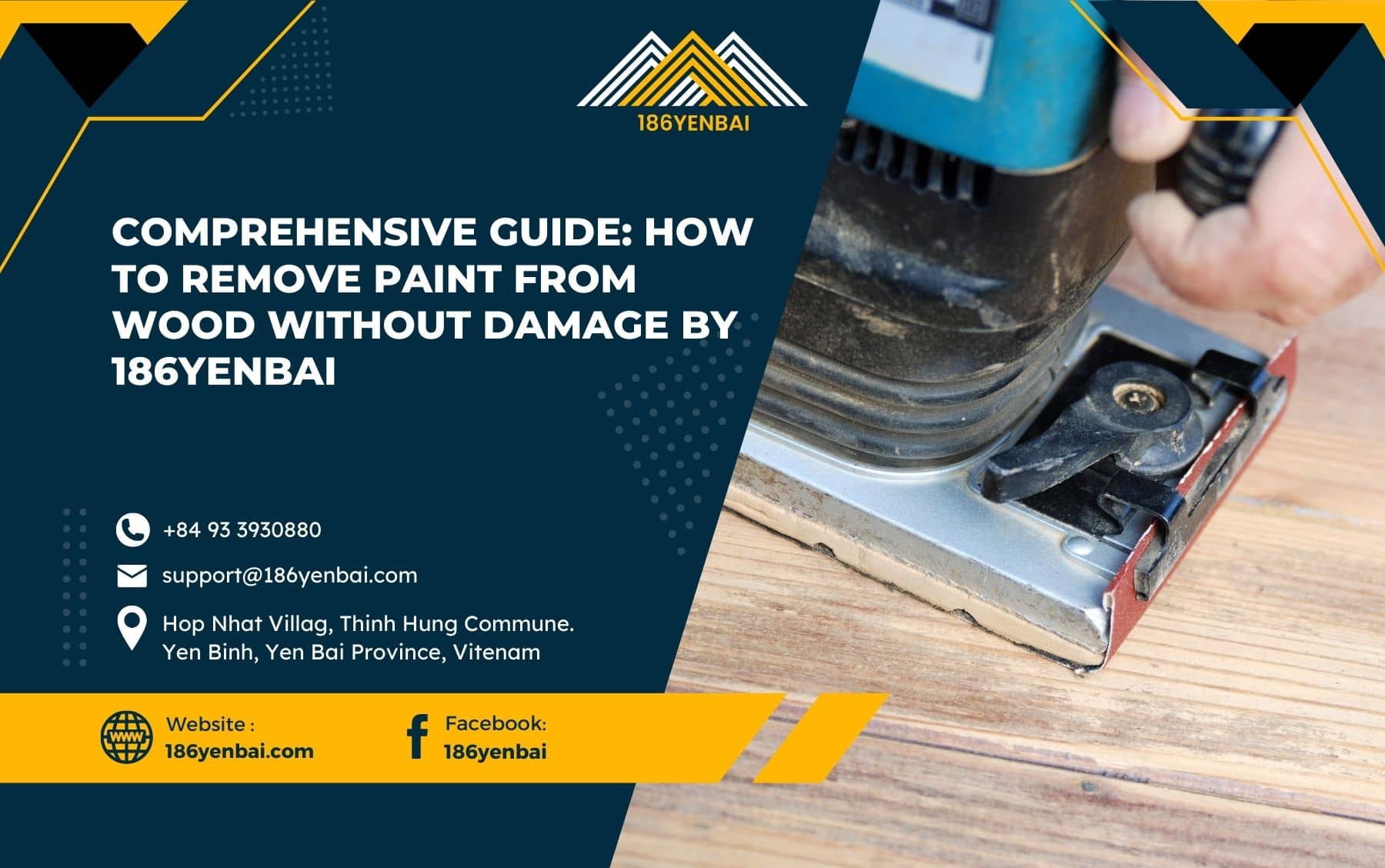Restoring the natural beauty of wooden furniture or preparing wood for a fresh coat of paint can be a rewarding project. However, the process of removing paint from wood must be done carefully to avoid damage. In this guide, we will explore various methods, tools, and tips for effectively removing paint from wood. From choosing the right paint stripper to understanding safe application techniques, this guide will help you tackle any paint removal project with confidence.

Table of Contents
ToggleWhy Remove Paint from Wood?
Over time, painted wood surfaces can become chipped, faded, or simply outdated. Whether you are restoring an antique piece, renovating your home, or giving a second-hand item a new look, removing old paint can bring out the natural beauty of the wood. Moreover, a clean, paint-free surface ensures that new paint or stain adheres evenly, providing a professional finish.
Related Articles: Particle Board vs Plywood: Which Material is Better for Your Project?
Types of Wood Suitable for Paint Removal
Almost all types of wood can be stripped of paint if the right techniques are used. Here are some common items that can benefit from paint removal:
- Furniture: Dressers, cabinets, tables, and chairs can be restored to their original look.
- Doors and Door Frames: Both interior and exterior doors can be refreshed by removing old paint.
- Flooring: Hardwood floors and parquet flooring can be stripped and refinished to enhance their natural grain.
- Built-In Fixtures: Shelving units, wall paneling, and skirting boards can be cleaned up for a new finish.
By understanding the wood type and selecting appropriate methods, you can achieve a clean, natural look while preserving the wood’s integrity.
Explore More: Can You Stain Pressure Treated Wood? A Comprehensive Guide by 186Yenbai
Methods to Remove Paint from Wood Without Damage
Here are three primary methods for safely removing paint from wood surfaces:
1. Sanding
Sanding is a straightforward technique ideal for flat, even surfaces. However, caution is needed to prevent damage.
- Best For: Flat surfaces and small projects.
- How It Works: Sanding uses abrasive action to remove paint from wood.
- Tips:
- Use fine-grit sandpaper to avoid scratching the wood.
- For large projects like floors, consider using an industrial sander.
- Apply even pressure to avoid creating indentations in the wood.
- Wear a mask to protect from dust particles.
2. Heat Gun
Using a heat gun is an efficient way to soften paint, making it easier to scrape off.
- Best For: Large, flat areas.
- How It Works: The heat gun softens the paint, allowing it to be scraped away.
- Tips:
- Hold the heat gun a few inches away from the surface to avoid scorching.
- Use a metal scraper to gently remove softened paint.
- Avoid using a heat gun on varnished wood, as it may become sticky and harder to remove.
3. Chemical Paint Strippers
For intricate woodwork or heavily painted surfaces, chemical strippers are often the best choice.
- Best For: Carved or intricate woodwork.
- How It Works: Chemical strippers dissolve the paint, making it easy to wipe or scrape off.
- Tips:
- Use in a well-ventilated area to avoid inhaling fumes.
- Wear protective gloves and goggles.
- Follow the manufacturer’s instructions carefully.
- Be mindful of chemical residues; wash the surface afterward to neutralize any remaining stripper.
Further Reading: MDF vs Plywood: Choosing the Right Material for Your Project with 186Yenbai
Types of Chemical Wood Strippers
Choosing the right chemical stripper depends on your project requirements and the type of paint you are removing. Here are two main types:
1. Solvent-Based Paint Strippers
These are gentler on wood, making them ideal for delicate pieces.
- Pros: Effective for all finishes, provides a finer finish, and penetrates deep into the wood.
- Cons: Higher cost and strong odor.
- Best For: Antique furniture or pieces where a natural finish is desired.
2. Caustic-Based Paint Strippers
Caustic-based strippers work quickly and are more budget-friendly.
- Pros: Effective on thick paint layers, suitable for heavy-duty applications.
- Cons: Can stain or react with dense woods like mahogany.
- Best For: Pine doors, window frames, or any piece being repainted or stained.
Learn More: The Ultimate Guide to Waterproofing Plywood: Top Methods and Tips from 186Yenbai
Step-by-Step Guide to Removing Paint from Wood
Follow these steps for safe and effective paint removal:
- Apply the Stripper: Use a brush to apply a generous amount of paint stripper to the wood surface, focusing on intricate areas.
- Let It Sit: Allow the stripper to work on the paint, as per product instructions (usually around 15-30 minutes).
- Scrape Off the Paint: Use a scraper to lift the softened paint. Steel wool or a wire brush can be used for tight corners.
- Repeat if Necessary: For stubborn paint patches, reapply the stripper and repeat the scraping process.
Tip: Follow up with a thorough wash to remove any residue, which can interfere with staining or refinishing.
Related Guide: Everything You Need to Know About Pressure Treated Plywood: A Guide by 186Yenbai
Safety Tips for Paint Removal
Paint removers contain strong chemicals that can be hazardous. Here are essential safety precautions:
- Wear Protective Gear: Always wear gloves, a mask, and goggles.
- Ventilation: Ensure proper ventilation when using chemical strippers indoors.
- Protect Surrounding Areas: Use a tarp or drop cloth to shield nearby surfaces.
- Avoid Open Flames: Paint removers are flammable; avoid using them near open flames.
- Secure Containers: Keep containers tightly sealed when not in use to prevent fumes.
Additional Resource: OSB and Plywood: Key Differences, Pros, and Cons Explained for 186Yenbai’s Clients
Alternative Methods: Homemade Paint Removers
If you prefer eco-friendly options, consider these homemade solutions:
- Vinegar: Heat vinegar and apply it to the painted surface. After about 15 minutes, use a scraper to lift the softened paint.
- Baking Soda and Water: Mix baking soda with water and apply it to the painted surface. Let it sit for a while, then scrape off the paint.
- Rubbing Alcohol and Lemon Juice: Combine three parts rubbing alcohol with one part lemon juice. Apply the mixture and let it sit, then scrape away the paint.
Note: Homemade solutions may require multiple applications, but they are safer and free of harsh chemicals.
Frequently Asked Questions
Can You Remove Paint Without Sanding?
Yes, using a paint stripper or a heat gun can effectively remove paint without the need for sanding. This approach is beneficial for preserving the natural texture of the wood.
Does Vinegar Remove Paint from Wood?
Yes, vinegar can help soften paint, making it easier to scrape off. However, vinegar alone is not as effective as commercial paint removers for thick or multiple layers of paint.

What is the Fastest Way to Remove Paint from Wood?
The quickest method is a combination of scraping and chemical strippers. Applying a stripper to soften the paint and then scraping it off can expedite the process.
Conclusion: Bringing Out the Natural Beauty of Wood
Removing paint from wood is a process that, when done correctly, can reveal the inherent beauty of the wood grain, allowing for a fresh and modern finish. By selecting the right methods and following safety precautions, you can efficiently and safely strip paint from any wooden surface. 186Yenbai offers a range of products and resources to support all your wood restoration projects.
For more information and expert advice, visit our website. Unlock the potential of your wooden surfaces with high-quality materials and reliable guidance from 186Yenbai.
For more information or inquiries about our high-quality plywood products, contact us at 186yenbai today to discuss how we can support your next construction or renovation project. Plywood Supplier
Phone: +84 93 3930880
Email: [email protected]
Facebook: https://www.facebook.com
Address: Hop Nhat Village, Thinh Hung Commune, Yen Binh, Yen Bai Province, Vietnam
Check out our other articles below:
Why High-Quality Plywood is the Ultimate Choice for Global Markets
High-Quality Plywood vs. Low-Quality Plywood: What’s the Difference?
5 Reasons Why High-Quality Plywood is the Best Choice for Home Renovations







